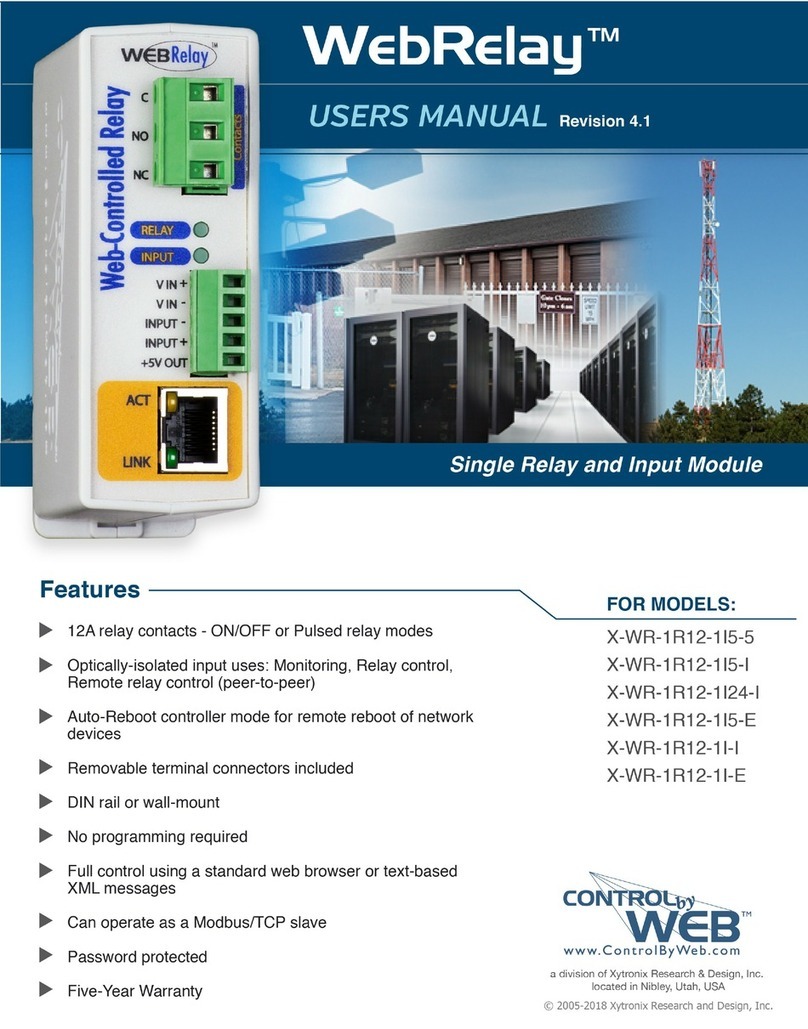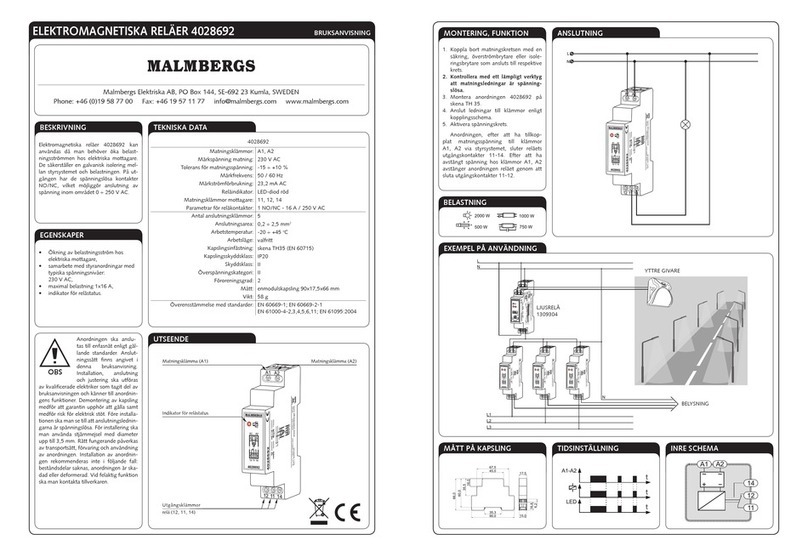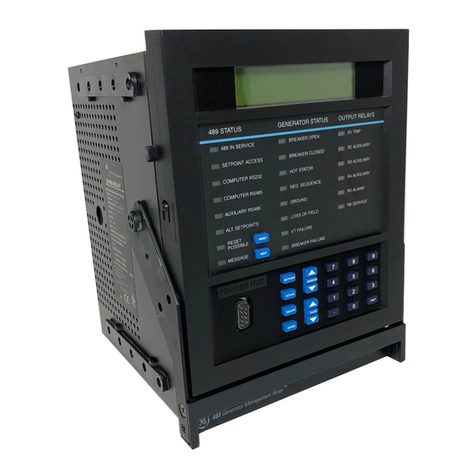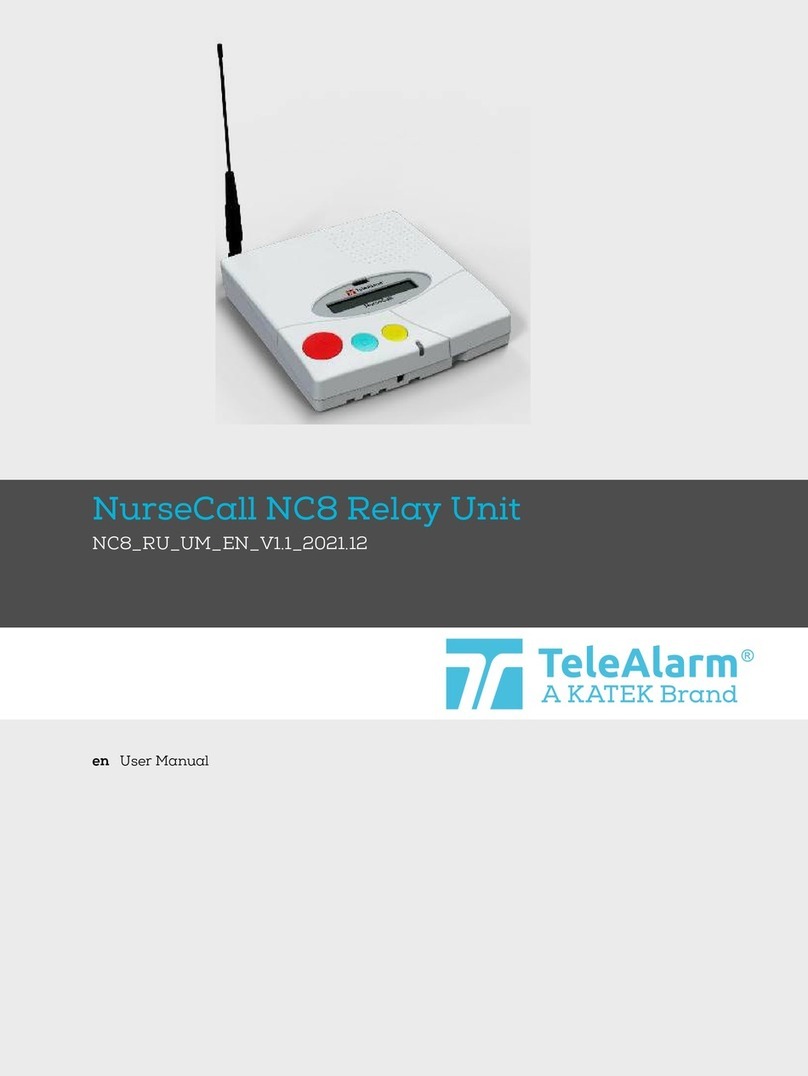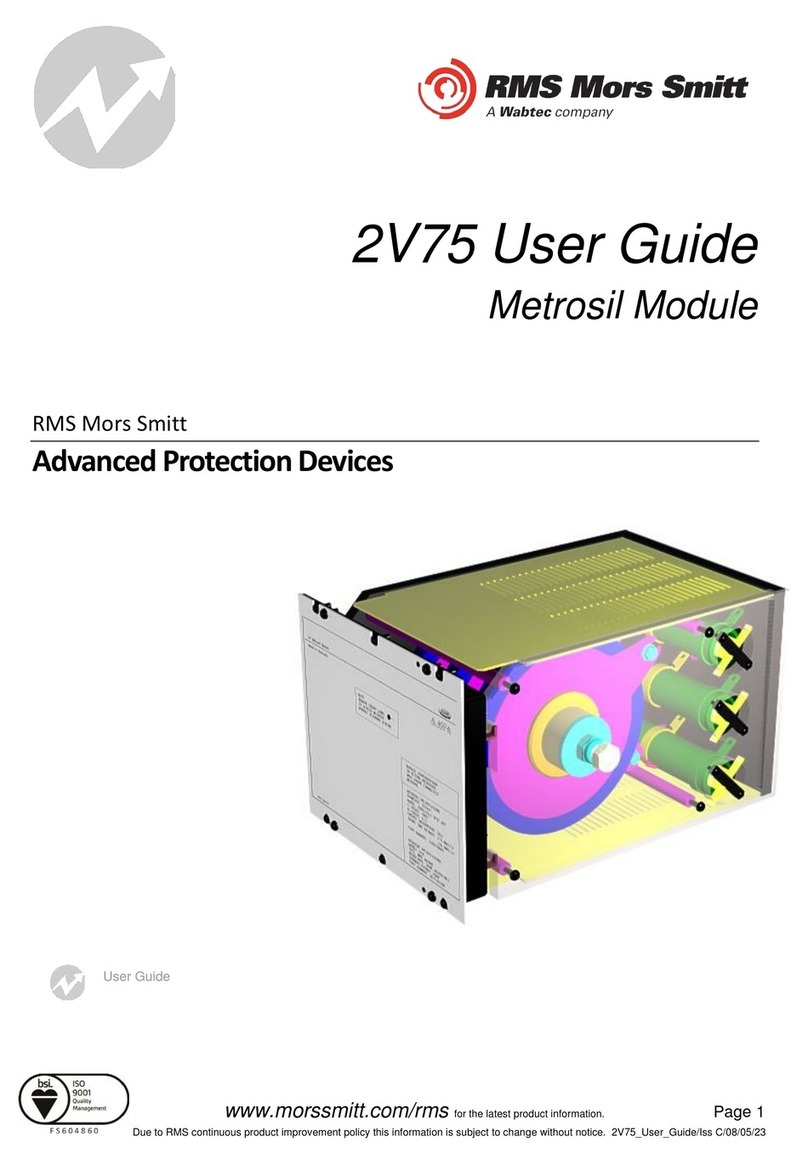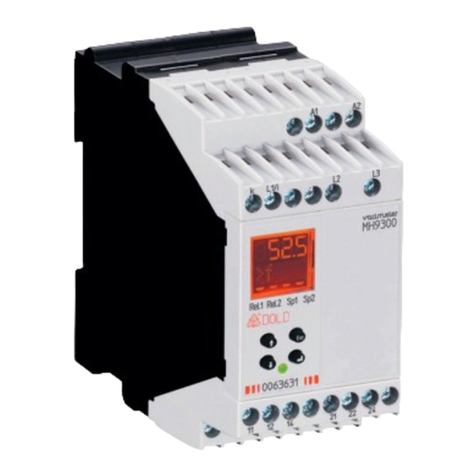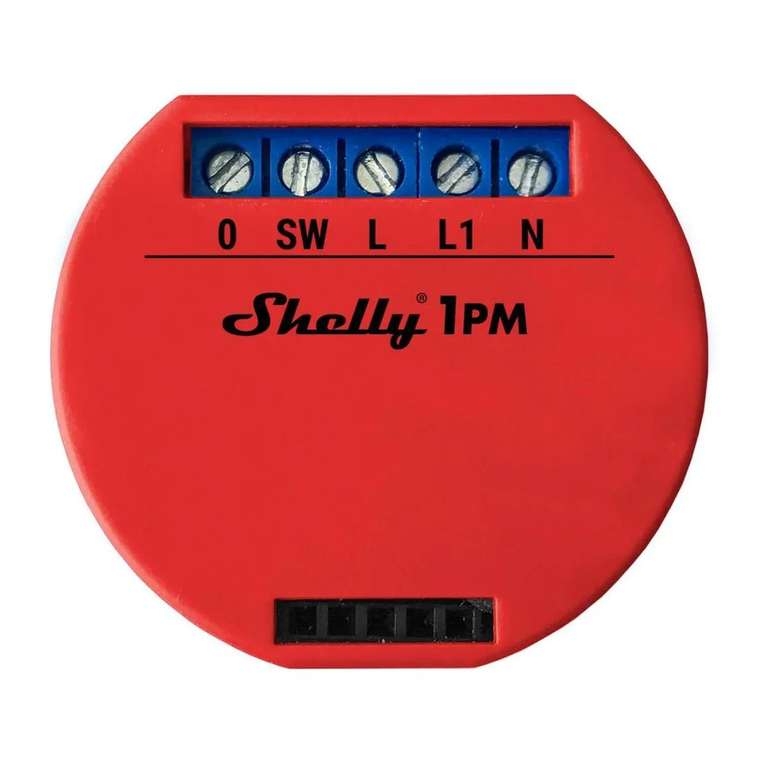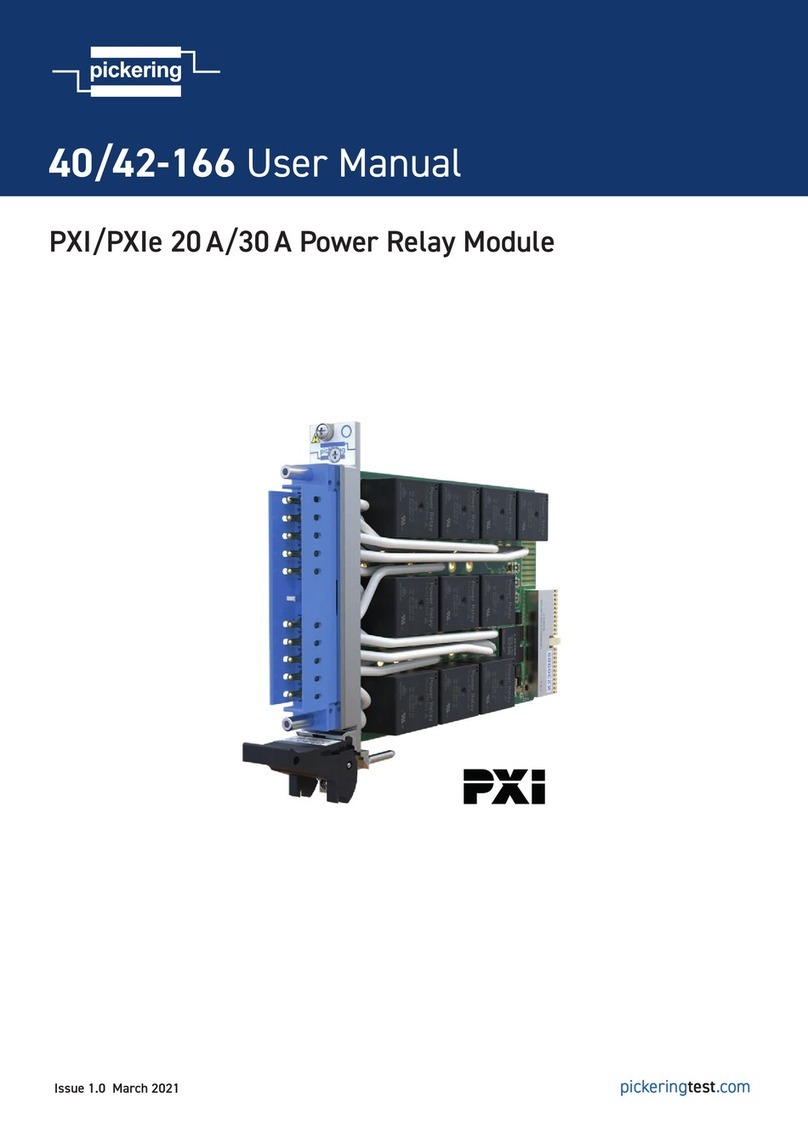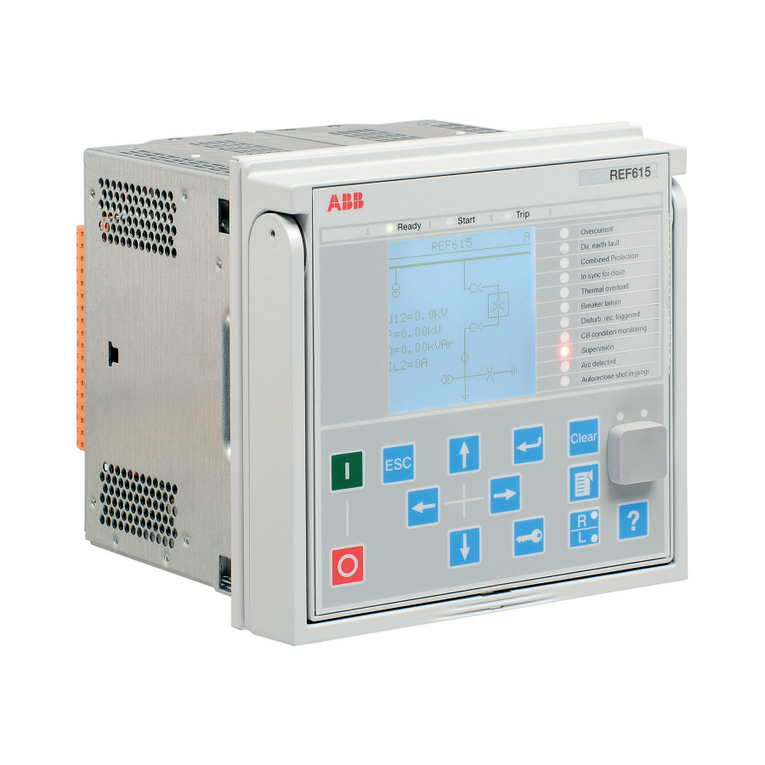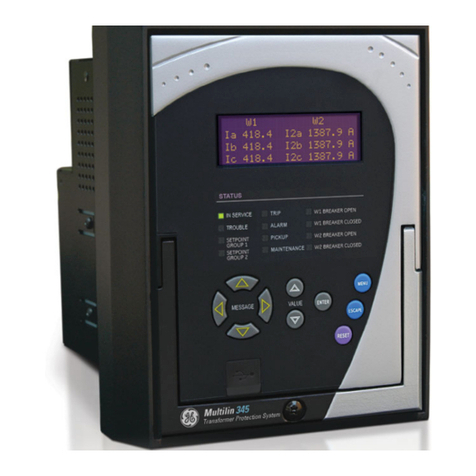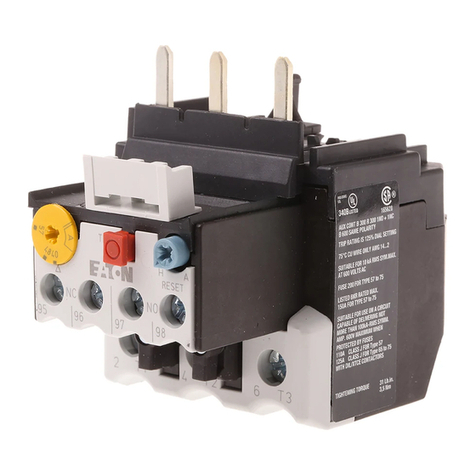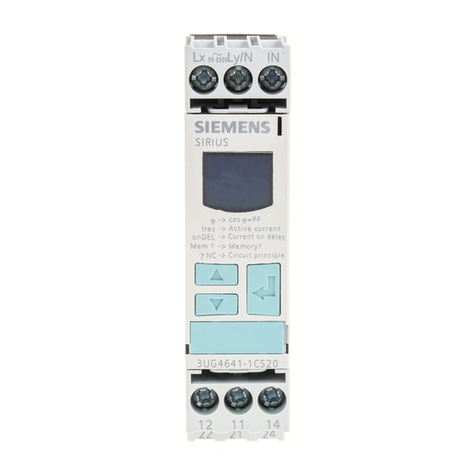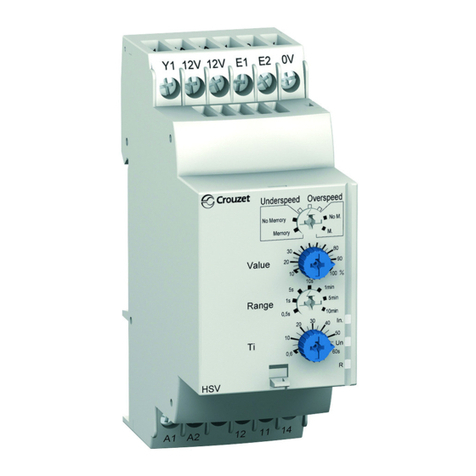Di-soric SR-1 User manual

Safety Technology
Instruction manual
Safety relays SR-1 and SR-M

INSTRUCTION MANUAL SAFETY RELAYS SR-1 + SR-M
2 State 03 / 2015 ■Rev. 0
English

INSTRUCTION MANUAL SAFETY RELAYS SR-1 + SR-M
State 03 / 2015 ■Rev. 0 3
English
Safety relays SR-1 and SR-M
CONTENT
INTRODUCTION ....................................................................................................... 4
RELAY SR-1 ............................................................................................................. 5
OPERATING MODES DESCRIPTION ......................................................................................... 5
Automatic .................................................................................................................................. 5
Manual....................................................................................................................................... 6
Connection of external contactors K1 and K2 ........................................................................... 7
SIGNAL DESCRIPTION ............................................................................................................... 8
The RESTART command.......................................................................................................... 8
K1 / K2 FEEDBACK input ......................................................................................................... 8
SYSTEM STATUS output ......................................................................................................... 8
INSTALLATION and ELECTRICAL CONNECTIONS ................................................................. 9
Characteristics of the output circuit ........................................................................................... 9
Use of K1 and K2 auxiliary contact elements............................................................................ 9
Warnings regarding the connection cables ............................................................................. 10
STATUS INDICATORS............................................................................................................... 10
DIMENSIONS.............................................................................................................................. 11
TECHNICAL DATA SR-1 ........................................................................................................... 12
STATUS INDICATORS / FAULT DIAGNOSIS........................................................................... 13
Status Indicators...................................................................................................................... 13
Fault Diagnosis........................................................................................................................ 13
RELAY SR-M .......................................................................................................... 14
OPERATING MODES DESCRIPTION ....................................................................................... 14
Automatic ................................................................................................................................ 14
Manual..................................................................................................................................... 15
Connection of K1 / K2 external contactors .............................................................................. 16
CONNECTON EXAMPLES ........................................................................................................ 17
Connection of the SR-M to a light barrier ................................................................................ 17
MUTING FUNCTION................................................................................................................... 18
Muting sequence ..................................................................................................................... 19
Muting OVERRIDE function .................................................................................................... 20
Override with maintained action control .................................................................................. 21
Override with pulse control...................................................................................................... 21
SIGNALS DESCRIPTION........................................................................................................... 22
The RESTART command........................................................................................................ 23
K1 / K2 FEEDBACK input ....................................................................................................... 23
SYSTEM STATUS output ....................................................................................................... 23
INSTALLATION and ELECTRICAL CONNECTIONS ............................................................... 24
Characteristics of the output circuit ......................................................................................... 24
Use of K1 and K2 auxiliary contact elements.......................................................................... 24
Warnings regarding the connection cables ............................................................................. 25
STATUS INDICATORS............................................................................................................... 25
DIMENSIONS.............................................................................................................................. 26
TECHNICAL DATA SR-M .......................................................................................................... 27
STATUS INDICATORS / FAULT DIAGNOSIS........................................................................... 28
Status Indicators BASE MODULE........................................................................................... 28
Status Indicators MUTING MODULE ...................................................................................... 28
Fault Diagnosis........................................................................................................................ 29
WARRANTY ........................................................................................................... 30
(Copy of the Original instructions)

INSTRUCTION MANUAL SAFETY RELAYS SR-1 + SR-M
4 State 03 / 2015 ■Rev. 0
English
INTRODUCTION
The SR-1 / SR-M relays, connected to an IEC 61496 – 1/2 certified type 4 safety light curtain
and equipped with two auto-controlled PNP type solid-state outputs, is a type 4 ESPE (Electro-
sensitive Protective Equipment).
The other characteristics indicated above remaining constant, if the safety light curtain is type 2,
the entire ESPE will be type 2.
The SR-1 main features are the following:
•Inputs for the connection of one safety barrier with fail safe outputs
•Restart manual or automatic selectable
•2 NO outputs with guided contact safety relays
•1 system monitor PNP output
•1 external contactors feedback input
The SR-M main features are the following:
•Inputs for the connection of one safety barrier with fail safe outputs
•Restart manual or automatic selectable
•2 NO outputs with guided contact safety relays
•1 system monitor PNP output
•1 external contactors feedback input
•Muting function with two sensors logic
•1 Muting function enable input
•1 muting lamp output
•Muting Override function integrated
•Selectable muting timeout
The safety modules also guarantees that:
•the output lines are open if the barrier is intercepted,
•the output lines are enabled only with correct response times,
•in manual mode, maintenance of the RESTART contact closed is not interpreted as
AUTO mode.
!For safe use of the device, it is essential to read and understand the contents of this
handbook.
!Failure to comply with the prescriptions indicated in this handbook may result in very
high risks for the operating personnel of the machine protected!

INSTRUCTION MANUAL SAFETY RELAYS SR-1 + SR-M
State 03 / 2015 ■Rev. 0 5
English
RELAY SR-1
OPERATING MODES DESCRIPTION
OPERATING MODES SELECTION
TERMINAL 5
TERMINAL 6
OPERATION
0 V DC
+24 V DC
Automatic
+24 V DC
0 V DC
Manual
0 V DC
0 V DC
Non-permissible conditions
+24 V DC
+24 V DC
Table 1
Automatic
In this operating mode, the outputs of the safety relay follow the status of the photocell:
•with the protected area free (outputs of the barrier active), the relay outputs of the control unit are
active.
•with the protected area occupied (outputs of the barrier de-activated), the relay outputs of the
safety module are de-activated.
Figure 1
!Use in manual mode (start/restart interlock activated) is mandatory in the case in which
the safety device controls an access protecting a danger zone and once a person has
passed through the opening, he / she may remain in the danger zone without being
detected (use as trip device according to IEC 61496). Failure to comply with this rule
may result in very serious risks for the persons exposed.

INSTRUCTION MANUAL SAFETY RELAYS SR-1 + SR-M
6 State 03 / 2015 ■Rev. 0
English
Manual
In this operating mode, the outputs of the control unit are activated only if the protected area is free
and after sending the RESTART signal to the control unit using the push-button or by means of a
specific command on the RESTART input (terminal 4).
Once the protected area has been occupied, the relay outputs are de-activated. The sequence
described above must be repeated in order to re-activate them.
The RESTART command is active with a voltage of 24 V DC.
The minimum duration of the command is 100 ms.
Figure 2
!Check correct functioning of the entire safety system (relay + barrier) following each
re-installation. In particular, if the original operating mode was Manual, check that the
unit has been reconfigured in this mode.

INSTRUCTION MANUAL SAFETY RELAYS SR-1 + SR-M
State 03 / 2015 ■Rev. 0 7
English
Connection of external contactors K1 and K2
Control of external contactors K1 / K2 can be activated in both operating modes.
If this control must be used, the series of normally closed contacts of the external contactors must
be connected to terminal 11 of the control unit (figures 3 and 4).
Figure 3
Automatic operation with K1 / K2 relays
Figure 4
Manual operation with K1 / K2 relays

INSTRUCTION MANUAL SAFETY RELAYS SR-1 + SR-M
8 State 03 / 2015 ■Rev. 0
English
SIGNAL DESCRIPTION
TERMINAL
NUMBER
SIGNAL
NAME
TYPE OF
SIGNAL
DESCRIPTION
1
24 V DC
Power supply 24 V DC
2
0 V DC
Power supply 0 V DC
3
PE
Ground connection
4
RESTART
Input
Restart command
5
MAN
Input
Manual / Automatic Configuration
6
AUTO
Input
7
INPUT 1 BARR
Input
Safety barrier input 1 status
8
INPUT 2 BARR
Input
Safety barrier input 2 status
9
n. c.
-
-
10
n. c.
-
-
11
K1 / K2 (Feedback)
Input
Feedback external contactors K1 / K2
12
SYSTEM STATUS
Output
Output status
13
Relay B No. 1
Output
Safety relay B, contact 1 (NO)
14
Relay B No. 2
Output
Safety relay B, contact 2 (NO)
15
Relay A No. 1
Output
Safety relay A, contact 1 (NO)
16
Relay A No. 2
Output
Safety relay A, contact 2 (NO)
Table 2
The RESTART command
•The RESTART command must be sent to the control unit connecting terminal 4 to the +24 V DC.
•
The contact used for the RESTART command must be able to switch a voltage of 24 V DC and a
current of 20 mA (guaranteeing a closing time > 100 ms). This data is particularly important in the
case of automatic management of the RESTART command sending, for example using a PLC
.
•The SYSTEM RESET TIME is obtained adding the reset time of any external contactors K1 / K2 to
the reset time of the SR-1 control unit (100 ms).
•In the case of manual activation, a normally open external button can be used, temporary closing
of which generates the RESTART command.
!The Restart command must be installed outside the danger area in a position where the
danger area and the entire work area concerned are clearly visible.
!It must not be possible to reach the control from inside the danger area.
K1 / K2 FEEDBACK input
Using the K1 and K2 auxiliary safety contactors with guided contact safety type, it is necessary to
connect the + 24 V DC to the K1 / K2 FEEDBACK through the series of the K1-1 and K2-1 NC
control contacts. The control of the correct switching of K1 and K2 is performed with a delay of
300 ms after the real command. When the K1-1 and K2-1 NC control contacts are not used (or
no
control is provided) it is mandatory to connect the terminal 11 (K1 / K2 FEEDBACK) to the +24 V DC.
SYSTEM STATUS output
The SYSTEM STATUS output reports exactly the output safety relays status:
•when the output relays are opened, the SYSTEM STATUS reports 0 V DC,
•when the output relays are closed, the SYSTEM STATUS reports +24 V DC.

INSTRUCTION MANUAL SAFETY RELAYS SR-1 + SR-M
State 03 / 2015 ■Rev. 0 9
English
INSTALLATION and ELECTRICAL CONNECTIONS
!Install the SR-1 safety relay in an environment with a protection rating of at least IP54.
!If more modules SR-1 must be installed in the same board panel, in order to avoid
overheating, maintain between them one minimal distance of 2 cm.
!The SR-1 control unit must be supplied with a 24 V DC ±20%.
!The external power supply must comply with the standard EN 60204-1.
!During the installation of the SR-1 control unit be sure to avoid short circuits between
the contacts 7 and 8.
Characteristics of the output circuit
For the output circuit, the control unit uses two guided contact safety relays.
These relays are rated by the manufacturer for voltage and current values above those indicated in
the technical data; however, to assure correct insulation and to avoid damage or premature aging,
protect each output line with a 4 A slow-blow fuse and check that load characteristics comply with
the indications given in the table below.
Minimum switching voltage
18 V DC
Minimum switching current
20 mA
Maximum switching voltage
250 V AC
Maximum switching current
2 A
Use of K1 and K2 auxiliary contact elements
For loads with higher voltage and current characteristics than those indicated in the table above,
use of auxiliary external relays or contactors suitable for the load to be controlled is recommended.
The K1 and K2 auxiliary contactors or relays must be of the guided contact safety type.
Referring to the table below, pay particular attention to the configuration of the control contacts on
terminal 11 and that of the contacts of use.
Relay K1
Relay K2
Control contacts
K1-1 normally closed
K2-1 normally closed
Use contacts
K1-2 normally open
K2-2 normally open
•Control contacts K1-1 and K2-1 (terminal 11) must be able to switch a current of 20 mA and
a voltage of 24 V DC.
•To increase the electrical life of internal relays A and B, it is advisable to use anti-disturbance
devices, which must be connected across the coils of K1 and K2.

INSTRUCTION MANUAL SAFETY RELAYS SR-1 + SR-M
10 State 03 / 2015 ■Rev. 0
English
Warnings regarding the connection cables
•For safety light curtain / control unit connections of more than 50 m, cables with a cross-section of
at least 1 mm2must be used.
•It is good practice to separate the power supply of the control unit from that of other electrical
appliances (electrical motors, inverters, frequency variators) or other sources of disturbance.
•The path of the connection cables between the control unit and the sensors, the connection
referring to the test command and feedback contacts connected to terminal 11 must be different
from that of other power cables.
STATUS INDICATORS
LED
COLOR
STATUS
CONDITION
IN
GREEN
ON
Barrier free
OFF
Barrier intercepted
FAIL
RED
ON
Fault detected *
OF
Correct operation
GUARD
BREAK
GREEN
RED
YELLOW
RED
Output relays opened
RED
blinking
The number of blinkings shows the
kind of FAIL (only with FAIL is ON) *
GREEN
Output relays closed
YELLOW
Barrier free - Output relays opened
(only in manual mode)
Table 3
* REFER TO THE "FAULT DIAGNOSIS" SECTION – PAGE 13 – TO HAVE
A DETAILED EXPLANATION OF THE POSSIBLE FAULT.
5 6 7 8
1 2 4
13 14 15 16
IN
FAIL
GUARD
BREAK

INSTRUCTION MANUAL SAFETY RELAYS SR-1 + SR-M
State 03 / 2015 ■Rev. 0 11
English
DIMENSIONS
Figure 5
99
114.5
22.5

INSTRUCTION MANUAL SAFETY RELAYS SR-1 + SR-M
12 State 03 / 2015 ■Rev. 0
English
TECHNICAL DATA SR-1
Safety category
Type 4
Power supply
V DC
24 ±20%
Power requirement
W
5 max.
Output
Relay
2 NO contacts (2 A; 250 V AC)
System Status Output
100 mA; 24 V DC
Response time
ms
20 max.
Operating modes
Manual or Automatic,
selectable from terminal block
External relay control
2 NC contacts (20 mA; 24 V DC)
Number of connectable barriers
1 (with 2 PNP safety static outputs)
Connections
Terminal block with protection
against reversal of polarity
Status indicators
LED
Power On – Barrier status – Fail
Max. length of connections
m
100
Operating temperature
°C
0 ÷ 55
Enclosure protection rating
IP 20
Terminal block
protection rating
IP 2X
Fastening
Fast attachment to rail according
to EN 50022-35
Dimensions (h x w x d)
mm
99 x 22,5 x 114,5
Weight
g
150
B10d
800.000
Device lifetime
20 years
Safety level
Type 4
IEC 61496-1: 2004
IEC 61496-2: 2006
SIL 3
IEC 61508: 1998
SILCL 3
IEC 62061: 2005
Cat. 4
ISO 13849-1: 2006
Load
Number of Commutations
PFHd *
DCavg #
MTTFd #
PL #
CCF #
2 A
at
230 V AC
1 every 30 sec
2,64E-08
98,92%
26,06
d
80%
1 every min
1,55E-08
98,85%
50,29
e
80%
1 every hour
4,93E-09
97,24%
100,00
e
80%
1 every day
4,77E-09
96,89%
100,00
e
80%
0,5 A
at
24 V DC
1 every 30 sec
4,86E-08
98,96%
13,28
d
80%
1 every min
2,64E-08
98,92%
26,06
d
80%
1 every hour
5,11E-09
97,51%
100,00
e
80%
1 every day
4,78E-09
96,91%
100,00
e
80%
Table 4
* IEC 61508
# ISO 13849-1

INSTRUCTION MANUAL SAFETY RELAYS SR-1 + SR-M
State 03 / 2015 ■Rev. 0 13
English
STATUS INDICATORS / FAULT DIAGNOSIS
Status Indicators
LED
MEANING
IN
GREEN
FAIL
RED
GUARD / BREAK
RED / GREEN
ON
ON
RED
Power on TEST
OFF
OFF
RED
Barrier INTERCEPTED,
outputs in OFF
ON
OFF
YELLOW
Barrier FREE, outputs in OFF
(relay waiting for RESTART)
ON
OFF
GREEN
Barrier FREE, outputs in ON
Table 5
Fault Diagnosis
LED
MEANING
IN
GREEN
FAIL
RED
GUARD / BREAK
RED / GREEN (pulses LED red)
OFF
ON
(2 pulses)
Internal fault
OFF
ON
(3 pulses)
Internal relays fault
OFF
ON
(4 pulses)
K1 / K2 external relays fault
OFF
ON
(5 pulses)
User configuration failure
OFF
ON
(6 pulses)
User configuration changed without
system restart:
Switch off and restart the relay to
solve the problem.
At the switch on verify the new user
configuration.
OFF
ON
(7 pulses)
Possible overload or
SYSTEM STATUS connection error
Table 6
!If it is not possible to clearly identify the malfunction and to remedy it, stop the
machine and contact the di-soric's Assistence Service.

INSTRUCTION MANUAL SAFETY RELAYS SR-1 + SR-M
14 State 03 / 2015 ■Rev. 0
English
RELAY SR-M
OPERATING MODES DESCRIPTION
OPERATING MODES SELECTION
TERMINAL 6
TERMINAL 15
OPERATION
0 V DC
+24 V DC
Automatic
+24 V DC
+24 V DC through a NO contact
Manual
0 V DC
0 V DC
Non-permissible conditions
+24 V DC
+24 V DC
Table 7
Automatic
In this operating mode, the outputs of the safety relay follow the status of the photocell:
•with the protected area free (outputs of the barrier active), the relay outputs of the control unit are
active.
•with the protected area occupied (outputs of the barrier de-activated), the relay outputs of the
safety module are de-activated.
Figure 6
NOTE: refer to the "CONNECTON EXAMPLES" section to see the muting signals connection –
Page 17

INSTRUCTION MANUAL SAFETY RELAYS SR-1 + SR-M
State 03 / 2015 ■Rev. 0 15
English
!Use in manual mode (start/restart interlock activated) is mandatory in the case in which
the safety device controls an access protecting a danger zone and once a person has
passed through the opening, he/she may remain in the danger zone without being
detected (use as trip device according to IEC 61496). Failure to comply with this rule
may result in very serious risks for the persons exposed.
Manual
In this operating mode, the outputs of the control unit are activated only if the protected area is free
and after sending the RESTART signal to the control unit using the push-button or by means of a
specific command on the RESTART input (terminal 15).
Once the protected area has been occupied, the relay outputs are de-activated. The sequence
described above must be repeated in order to re-activate them.
The RESTART command is active with a voltage of 24 V DC.
The minimum duration of the command is 100 ms.
Figure 7
NOTE: refer to the "CONNECTON EXAMPLES" section to see the muting signals connection –
Page 17
!Check correct functioning of the entire safety system (relay + barrier) following each
re-installation. In particular, if the original operating mode was Manual, check that the
unit has been reconfigured in this mode.

INSTRUCTION MANUAL SAFETY RELAYS SR-1 + SR-M
16 State 03 / 2015 ■Rev. 0
English
Connection of K1 / K2 external contactors
Control of external contactors K1 / K2 can be activated in both operating modes. If this control is to be
used, the set of normally closed contacts of the external contactors must be connected to terminal 20
of the safety module (Figure 8 and Figure 9).
Figure 8
Automatic operation with K1 / K2 relays
Figure 9
Manual operation with K1 / K2 relays
NOTE: refer to the "CONNECTON EXAMPLES" section to see the muting signals connection –
Page 17

INSTRUCTION MANUAL SAFETY RELAYS SR-1 + SR-M
State 03 / 2015 ■Rev. 0 17
English
CONNECTON EXAMPLES
Connection of the SR-M to a light barrier
manual mode, working range = HI, external contactors K1 / K2, timeout muting = 30 s
Figure 10

INSTRUCTION MANUAL SAFETY RELAYS SR-1 + SR-M
18 State 03 / 2015 ■Rev. 0
English
MUTING FUNCTION
!The Muting function is a temporary suspension of the safety light curtain’s protective
function. Carefully check your risk analysis in order to assess whether the Muting
function is compatible with your application and what additional measures have to be
taken.
The Muting function generates a temporary, automatic interruption of the protective action of the
barrier in order to permit normal transit of material through the guarded opening.
The Muting function is activated when the system detects the object that interrupts the opening
protected. In other words, when the system recognizes the material and distinguishes between this
and any operator (in a potentially dangerous situation), it is enabled to bypass the light curtain
temporarily, allowing the material to pass through the opening (Figure 11).
The Muting sensors form the sensing system that decides whether the Muting function is to be
activated (or not). Control of the dangerous opening can be de-activated only by a correct
sequence of interruption of the beams of the Muting sensors.
Figure 11
Muting on palletizing system application example

INSTRUCTION MANUAL SAFETY RELAYS SR-1 + SR-M
State 03 / 2015 ■Rev. 0 19
English
Muting sequence
The muting function is initiated by the contemporary occurrence of two events:
•when the two beams of the muting sensors are activated within a time limit of 4 sec.
•when the muting enable signal (terminal 11) is high (+24 V DC).
The muting function is terminated by one of the following events:
•as soon as one of the muting sensors is no longer activated whichever occurs first
•when the muting time-out limit is expired; in this case the OSSDs are brought to the off-state.
The muting time-out limit can be selected at 30 sec or ∞.
The timing diagrams in Figure 12 and Figure 13 show the correct signal sequence.
The muting enable command will only enable the muting function and should be generated at
the appropriate time by the machine control system (e.g. When the muting function is
needed); it has no effect on the deactivation of the muting function. If not used, fix the
terminal 11 at +24 V DC.
Remember that muting is a temporary automatic suspension of the safety function.
This means that a time limit is always mandatory. If a time out limit of 30 sec is a too short
time for a particular machine cycle, the configuration without time monitoring (t = ∞) can be
selected. In this case alternative solutions or additional measures shall be implemented to
detect the condition of a muting function permanently active caused by accumulation
of faults or by the muting sensors activated all the time. For example for the application of
guarding the openings of a conveyor system (palletizers) by monitoring appropriate signals
generated by the transport system to determinate if and when a pallet is in the detection
zone.
Figure 12
Muting cycle
SENSOR 1
SENSOR 2
MUTING
FIELD FREE
FIELD INTERRUPTED
TIMER 4 SEC

INSTRUCTION MANUAL SAFETY RELAYS SR-1 + SR-M
20 State 03 / 2015 ■Rev. 0
English
Figure 13
Muting cycle closed by a timeout
Muting OVERRIDE function
The OVERRIDE function must be used when the machine stops due to incorrect Muting activation
sequences with the material obstructing the guarded opening.
In this situation, the OSSD outputs are not active as the barrier and/or at least one Muting sensor
is occupied. In this condition the OVERRIDE request led blinks.
(ref. "Status Indicators" – Page 25).
!This function activates the OSSD outputs making it possible to remove the material that
is obstructing the protected field.
!Throughout the entire phase during which the OVERRIDE function is active, the
OVERRIDE / MUTING light blinks. Check efficiency of this light periodically (during the
Muting or Override phases).
!Warning!! The Override with pulse command automatically activates the outputs of the
light curtain until both the light curtain and the muting sensors are free of obstacles
again. During this period, the light curtain is unable to protect access to the guarded
opening. Therefore, all operations must be carried out under the strict supervision of
expert personnel.
!During the installation of the module be sure to avoid short circuits between the
contacts 7 and 8.
SENSOR 1
SENSOR 2
MUTING
FIELD FREE
FIELD INTERRUPTED
TIMER 4 SEC
This manual suits for next models
1
Table of contents
